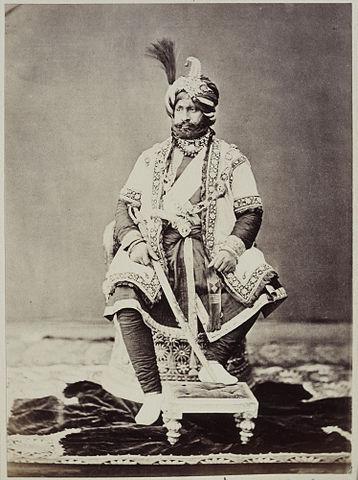Recognition as Maharaja Gulab Singh:
Meanwhile, in the continuing intrigues at Lahore, the Sandhawalia Sardars (related to Ranjit Singh) murdered Raja Dhian Singh and the Sikh Maharaja Sher Singh in 1842.Subsequently, Gulab Singh’s youngest brother, Suchet Singh, and nephew, Hira Singh, were also murdered. As the administration collapsed the Khalsa soldiery clamored for the arrears of their pay. In 1844 the Lahore court commanded an invasion of Jammu to extract money from Gulab Singh, reputed to be the richest Raja north of the Sutlej River as he had taken most of the Lahore treasury.
However, the Gulab Singh agreed to negotiate on his behalf with the Lahore court. These negotiations imposed an indemnity of 27 lakh Nanakshahee Rupees on the Raja.
Lacking the resources to occupy such a large region immediately after annexing portions of Punjab, the British recognised Gulab Singh as a Maharaja directly tributary to them on payment of 75 thousand Nanakshahee Rupees for the war-indemnity (this payment was justified on account of Gulab Singh legally being one of the chiefs of the Kingdom of Lahore and thus responsible for its treaty obligations). The angry courtiers of Lahore (particularly the baptized Sikh, Lal Singh) then incited the governor of Kashmir to rebel against Gulab Singh, but this rebellion was defeated, thanks in great part to the action of Herbert Edwardes, Assistant Resident at Lahore. In the second Sikh War of 1849, he allowed his Sikh soldiers to desert and go to fight alongside their brethren in Punjab. The treaties of Chushul and Amritsar had defined the borders of the Kingdom of Jammu in the east, south, and west but the northern border was still undefined. In 1850 the fort of Chilas in the Dard country was conquered.
Maharaja Gulab Singh died on 30 June 1857 and was succeeded by his son, Ranbir Singh.
Meanwhile, in the continuing intrigues at Lahore, the Sandhawalia Sardars (related to Ranjit Singh) murdered Raja Dhian Singh and the Sikh Maharaja Sher Singh in 1842.Subsequently, Gulab Singh’s youngest brother, Suchet Singh, and nephew, Hira Singh, were also murdered. As the administration collapsed the Khalsa soldiery clamored for the arrears of their pay. In 1844 the Lahore court commanded an invasion of Jammu to extract money from Gulab Singh, reputed to be the richest Raja north of the Sutlej River as he had taken most of the Lahore treasury.
However, the Gulab Singh agreed to negotiate on his behalf with the Lahore court. These negotiations imposed an indemnity of 27 lakh Nanakshahee Rupees on the Raja.
Lacking the resources to occupy such a large region immediately after annexing portions of Punjab, the British recognised Gulab Singh as a Maharaja directly tributary to them on payment of 75 thousand Nanakshahee Rupees for the war-indemnity (this payment was justified on account of Gulab Singh legally being one of the chiefs of the Kingdom of Lahore and thus responsible for its treaty obligations). The angry courtiers of Lahore (particularly the baptized Sikh, Lal Singh) then incited the governor of Kashmir to rebel against Gulab Singh, but this rebellion was defeated, thanks in great part to the action of Herbert Edwardes, Assistant Resident at Lahore. In the second Sikh War of 1849, he allowed his Sikh soldiers to desert and go to fight alongside their brethren in Punjab. The treaties of Chushul and Amritsar had defined the borders of the Kingdom of Jammu in the east, south, and west but the northern border was still undefined. In 1850 the fort of Chilas in the Dard country was conquered.
Maharaja Gulab Singh died on 30 June 1857 and was succeeded by his son, Ranbir Singh.
Recognition as Maharaja Gulab Singh:
Meanwhile, in the continuing intrigues at Lahore, the Sandhawalia Sardars (related to Ranjit Singh) murdered Raja Dhian Singh and the Sikh Maharaja Sher Singh in 1842.Subsequently, Gulab Singh’s youngest brother, Suchet Singh, and nephew, Hira Singh, were also murdered. As the administration collapsed the Khalsa soldiery clamored for the arrears of their pay. In 1844 the Lahore court commanded an invasion of Jammu to extract money from Gulab Singh, reputed to be the richest Raja north of the Sutlej River as he had taken most of the Lahore treasury.
However, the Gulab Singh agreed to negotiate on his behalf with the Lahore court. These negotiations imposed an indemnity of 27 lakh Nanakshahee Rupees on the Raja.
Lacking the resources to occupy such a large region immediately after annexing portions of Punjab, the British recognised Gulab Singh as a Maharaja directly tributary to them on payment of 75 thousand Nanakshahee Rupees for the war-indemnity (this payment was justified on account of Gulab Singh legally being one of the chiefs of the Kingdom of Lahore and thus responsible for its treaty obligations). The angry courtiers of Lahore (particularly the baptized Sikh, Lal Singh) then incited the governor of Kashmir to rebel against Gulab Singh, but this rebellion was defeated, thanks in great part to the action of Herbert Edwardes, Assistant Resident at Lahore. In the second Sikh War of 1849, he allowed his Sikh soldiers to desert and go to fight alongside their brethren in Punjab. The treaties of Chushul and Amritsar had defined the borders of the Kingdom of Jammu in the east, south, and west but the northern border was still undefined. In 1850 the fort of Chilas in the Dard country was conquered.
Maharaja Gulab Singh died on 30 June 1857 and was succeeded by his son, Ranbir Singh.
0 Comentários
0 Compartilhamentos
0 Anterior




